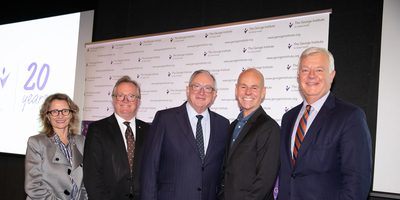
20 years of improving critical care
The George Institute's different approach to critical care research has not only saved countless lives, but also been highly cost-effective, says intensive care specialist and researcher Professor John Myburgh AO.
In the early 1990s, there was limited research on how to improve outcomes for intensive care unit (ICU) patients in Australia.
Up to 15% of ICU patients were dying but a determined group of Australian and New Zealand ICU doctors, including John, wanted to change this. They began running small clinical trials to try to improve both care and survival rates for their sickest patients.
By 1999, the year The George Institute was formed, John and the team were making good progress and were ready to conduct their biggest trial yet – the ambitious SAFE study – which aimed to establish if a commonly used resuscitation fluid called albumin was actually increasing deaths.
“People said we were crazy for attempting this major trial of 7,000 patients – that we didn’t have the expertise and ability,” recalls John. “But when we went to see [The George Institute co-founders] Robyn Norton and Stephen MacMahon, they didn’t say ‘It can’t be done’; they said, ‘How can we help you?’”
It was fortunate they did. The study proved to be a game-changer in ICU medicine, demonstrating beyond question that recovery rates for patients with traumatic brain injury were indeed much higher if doctors avoided administering albumin.
The study also offered an exciting new model for large-scale clinical trials, paving the way for the Institute to conduct numerous other trials over the next two decades.
“A subsequent study we did in intensive care called CHEST looked at whether or not the use of a particular starch for fluid resuscitation was increasing death and kidney failure in ICU patients,” he says. “Our study showed it did and was instrumental in getting this product removed from clinical practice around the world. It’s likely tens of thousands of lives have been saved as a result.”
“The George Institute was front and centre with that study, I was the lead investigator. In many ways, that study was one of the highlights of my 40-year ICU career and I think a highlight of The George Institute's contribution to the sector.”
Another study, ADRENAL, looked at the use of hydrocortisone steroids in reducing mortality in patients admitted to an ICU with septic shock. It found the steroids not only reduced the duration of septic shock, but also the time spent on life support therapy in intensive care, thereby saving treatment costs.
ADRENAL’s impact was clear from the outset. It was the first Australian ICU trial to be included in the UK’s Portfolio of the National Institute of Health Research, facilitating UK resource support. It was also a finalist in the 2019 Australian Clinical Trials Alliance’s (ACTA) Clinical Trial of the Year Award and won the STING Award for Statistical Excellence.
SAFE and CHEST were the two largest Randomised Controlled Trials (RCTs) ever conducted in intensive care medicine until the Institute’s PLUS study was launched in 2016. PLUS is examining the impact on mortality of normal saline compared with a balanced solution among 8,800 critically ill patients across 40 study sites, with preliminary findings suggesting the latter reduced relative risk of death by 12.5%. Full results are expected to be published in 2021.
These trials have significantly influenced clinical practice and medical regulatory authorities worldwide, and have helped improve how common life-threatening problems facing ICU patients are treated around the world.
However it’s not just lives that are saved by such ambitious research.
“A study looking at the impact of our trials found thousands of lives have been saved and significant savings have been made to the Australian economy,” John says. “As intensive care units emerge in less-developed countries like Brazil and China, a lot of the research we’ve done will be just as applicable there as it is in Australia, Europe and the US.”
John believes this patient-centred, outcome-based approach to research has been a fundamental ingredient in The George Institute’s ability to affect change for so many people around the world in such a short amount of time.
“None of us really had any idea when we first started doing these trials 20 years ago that we could have ended up where we are now,” he says.
Celebrating 20 years: John’s top moments
- Running the SAFE study: “Stephen and Robyn had a can-do, how can we help you approach, which I found very inspirational. It’s something I’m extremely grateful for and, when people come and ask me for help, something I’ve modelled my own responses on.”
- Turning research into results: “It’s really inspirational when we finish a trial, publish the results and see changes take place in clinical practice globally.”
- Saving lives and money: “The implementation of the results of our studies over the last 20 years has resulted in thousands of deaths avoided and millions of dollars saved.”


